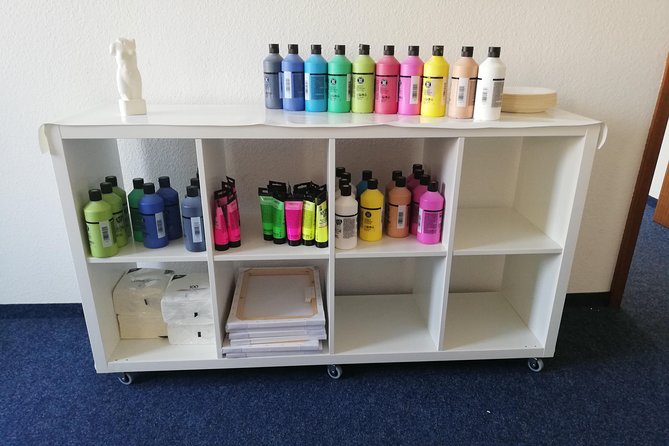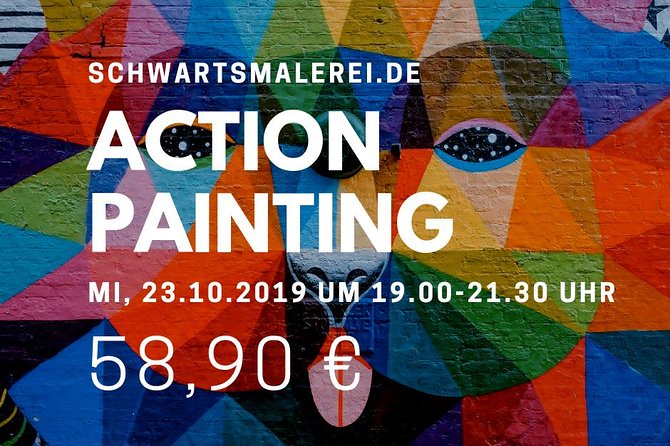Action Painting
In the world of art, action painting stands as a swirling canvas where emotions dance like vibrant brushstrokes on a blank page. This dynamic form of artistic expression captivates viewers with its raw energy and unbridled creativity, challenging conventional notions of what constitutes a masterpiece.
But what lies beneath the surface of these chaotic splatters and bold gestures? Explore the secrets behind this revolutionary movement, from its inception to its enduring influence on contemporary art practices.
Key Points
- Action Painting revolutionized art with dynamic, gestural approaches emphasizing inner emotions.
- Techniques include bold brushstrokes, unconventional tools, and dripping paint for expressive physicality.
- Famous artists like Pollock and de Kooning each brought distinctive styles and techniques.
- Impact on contemporary art seen in emphasis on expression, spontaneity, and creative freedom.
Here's some more nearby activities we've reviewed
History of Action Painting
Emerging in the mid-20th century, Action Painting, also known as gestural abstraction, revolutionized the art world with its dynamic and spontaneous approach to creating art.
This style emphasized the psychological aspects of the artistic process, focusing on the expression of the artist’s inner emotions and thoughts through bold and energetic brushstrokes.
Artists engaged in this movement believed in the importance of the act of painting itself, viewing it as a performance where the physical gestures and movements of the artist were as significant as the final artwork.
Action Painting allowed for a direct connection between the artist’s subconscious and the canvas, resulting in raw and powerful creations that captured the essence of the moment.
Techniques and Tools Used

Utilizing a combination of bold brushstrokes and spontaneous movements, artists in Action Painting employed dynamic techniques and tools to convey their inner emotions onto the canvas.
Action painting innovations were characterized by the use of unconventional tools such as sticks, knives, and even dripping paint straight from the can. This technique allowed for a direct and unmediated connection between the artist’s movements and the artwork.
Artists engaged in Action painting experimentation by exploring the physicality of paint application, embracing accidents and chance as integral parts of the creative process. By letting go of traditional methods of painting, these artists pushed the boundaries of artistic expression and paved the way for a new form of abstract art that emphasized the act of painting itself.
Famous Action Painters

Some of the most renowned figures in the realm of Action Painting include Jackson Pollock, Willem de Kooning, and Franz Kline. These influential artists revolutionized the art world with their unique approaches to painting. Each artist brought a distinctive style and technique to their work, contributing to the evolution of the Action Painting movement.
-
Jackson Pollock: Known for his iconic drip painting technique, Pollock’s innovative methods pushed the boundaries of traditional painting.
-
Willem de Kooning: His expressive brushwork and dynamic compositions captured the essence of Abstract Expressionism, influencing generations of artists.
-
Franz Kline: Recognized for his bold, gestural brushstrokes and strong contrasts of black and white, Kline’s work exemplifies the power and energy of Action Painting.
-
Helen Frankenthaler: Pioneering the soak-stain technique, Frankenthaler created ethereal and lyrical compositions that expanded the possibilities of abstract art.
Impact on Contemporary Art
The groundbreaking techniques and expressive styles pioneered by famous Action Painters such as Jackson Pollock and Willem de Kooning continue to reverberate through contemporary art, influencing artists and challenging traditional notions of painting.
In today’s art scene, the impact of Action Painting is evident in the emphasis on artistic expression and the creative process. Artists draw inspiration from the spontaneity and energy of Action Painting, pushing boundaries and exploring new ways to engage with their work.
This influence is particularly notable in abstract and experimental art forms, where artists seek to capture raw emotions and movement on canvas. The legacy of Action Painting lives on as a driving force behind the evolution of contemporary art, encouraging artists to embrace freedom and innovation in their craft.
Tips for Trying Action Painting
For those looking to explore the world of Action Painting, consider these essential tips to enhance your experience and creativity on the canvas.
- Experiment with DIY projects to create unique tools for applying paint.
- Embrace the spontaneity and freedom of Abstract Expressionism in your work.
- Use a variety of tools beyond traditional brushes to add texture and depth.
- Don’t be afraid to make bold, sweeping gestures to convey emotion and energy in your paintings.
Here's a few more nearby tours and experiences we have reviewed.
- City Tour Karlsruhe in a Double-Decker Bus
- Black Forest. From Baden-Baden to Strasbourg. Two Countries in One Day
- Baden-Baden to Karlsruhe Airport (FKB) Departure Private Transfer
- Hometown Karlsruhe: City Walk Through Karlsruhe
- Romance in Baden-Baden – Private Walking Tour
- Private Family Tour in Baden-Baden’s Treasures
Common questions
What Are Some Common Misconceptions About Action Painting?
Many misconceptions exist about action painting, a misunderstood technique of artistic expression. People often misunderstand its creative process, leading to misconceptions about spontaneity, chaos, and lack of skill in this vibrant form of art.
How Does Action Painting Differ From Other Forms of Abstract Art?
Action painting distinguishes itself through the spontaneous creation of art, prioritizing emotional expression over precise control. This approach sets it apart from other forms of abstract art by emphasizing the immediacy and raw energy of the artistic process.
Are There Any Controversies or Debates Surrounding Action Painting?
In the art world, controversies and debates often arise, questioning the boundaries of artistic freedom and expression. These discussions can lead to insightful dialogues that challenge traditional norms and push the boundaries of creativity.
How Has the Digital Age Impacted the Practice of Action Painting?
The digital age has revolutionized art by providing artists with new tools and platforms to showcase their work globally. Traditional methods blend with digital tools, enhancing accessibility and reaching wider audiences, transforming the practice of art in unprecedented ways.
Can Action Painting Be Considered a Form of Performance Art?
When considering art as a form of performance, the intertwining of physical movement with artistic expression can create a dynamic experience. Spontaneity and creativity fuel this fusion, leading to a captivating display that blurs the line between art and performance.
Here's more of our most recent tour reviews happening neaby
- Self-Guided City Rally / Scavenger Hunt Karlsruhe in German
- Baden-Baden Thermal to Stuttgart Airport (STR) Departure Transfer
- Baden-Baden Thermal to Frankfurt Airport (FRA) Departure Transfer
- Karlsruhe Private Guided Walking Tour
- Baden-Baden Private Walking Tour With A Professional Guide
- Private Walking Tour in Baden Neuweirs Vineyard
- Mulled Wine Walk Around Karlsruhe Castle
- Day Trip From Baden-Baden to Strasbourg
- Baden-Baden Yuletide Stroll: Experience the Festive Charm
- Transfer From Baden-Baden to Frankfurt Airport
- Picturesque Beauties of Baden-Baden – Guided Walking Tour
Last Words
To sum it up, action painting revolutionized the art world by emphasizing the process of creation over the final product. Through spontaneous brushstrokes and innovative techniques, artists like Jackson Pollock and Willem de Kooning pushed boundaries and challenged traditional norms.
Their impact on contemporary art can still be seen today, inspiring artists to experiment and express themselves freely. For those looking to try action painting, remember to embrace the moment, let go of control, and allow your creativity to flow freely onto the canvas.